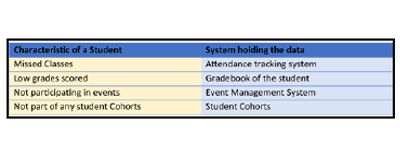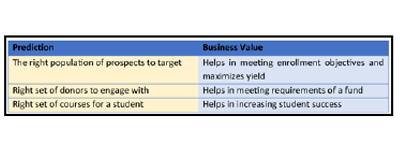Technology Integration And Business Intelligence Strategy In The Education Industry
With the advancements in the technology space, the cost of storing data is steadily decreasing. Today, a thumb drive in your pocket can store the information that was stored across multiple hard drives a decade ago. As more and more data is being captured, there arises a challenge to process that data into meaningful information. Technology innovation in over next decade will improve the power to process large amounts of data that seems impossible today without large scale server farms. This should facilitate some interesting transformations in the technology landscape of Business Intelligence products and platforms.
In the past, Business Intelligence was limited to a simple spreadsheet stored on the desktop of an office clerk. Today, these are powerful systems that run across the enterprise and constantly generate information that is required for decision making. In the future, this will transform into systems that are capable of relating unrelated data to derive meaningful information that could power the decision-making process in ways that have never been witnessed so far. Advances in machine learning will pave the way for success in building Business Intelligence systems with predictive analytics capabilities.
The Need for Business Intelligence in Higher Education
A higher education institution is similar to any large-scale enterprise where decisions are driven based on information derived from a large amount of data. Business Intelligence systems help in creating that information. For instance, the staff of an institution should be able to review the characteristics of a student to determine the risk of a student dropping out. These characteristics may be present in disparate and siloed systems in a university ecosystem. The table below outlines the characteristics and the likely system they are part of.
Business Intelligence systems help to retrieve the data holding the characteristics of a student and derive useful information on the probability of a student dropping out.
Connected Campus Shortens the Time to Make Right Decisions
To build a robust Business Intelligence system it is very important to break the boundaries between the disparate systems, building integration between them that can enable the processing of meaningful information. The best Business Intelligence systems shorten the cycle for decision making thereby improving the operational efficiency of the institution. This is a true characteristic of what is called a `Connected Campus'.

Business Intelligence Powered by Machine Learning
Thanks to the advancements made in the field of processing power, Machine Learning has become more practical and viable. This has opened up new avenues that could not have been explored in the past.

The student retention example discussed before was just based on a fixed set of characteristics like attendance, grades and so on. Machine Learning now provides the ability to draw a correlation between a large set of characteristics that impact the probability of student success. A Machine Learning model could help an institution arrive at more meaningful information derived from a large dataset containing student characteristics. This could enable the institution to identify students at risk at an early stage and take measures to retain them.
Machine Learning is one of the statistical techniques of Predictive Analytics. Using Predictive Analytics models institutions can process historical data to predict various information that would improve operational efficiency. The table below illustrates some of the predictions that can be made by Machine Learning algorithms and the corresponding value it provides. This is just a sample as the possibilities can be many.
Business Intelligence, a Key Strategy for Institutional Performance
Implementing a Business Intelligence system should be part of the strategic objectives of institutions. This system will need to cut across the boundaries of disparate systems to be effective in improving institutional performance, thus integration should be at the heart of the strategy. A well-designed integration platform like Ellucian Ethos that leverages the higher education open data model can help to create an empowered campus by connecting people, processes and technology.
To build a robust Business Intelligence system it is very important to break the boundaries between the disparate systems, building integration between them that can enable the processing of meaningful information. The best Business Intelligence systems shorten the cycle for decision making thereby improving the operational efficiency of the institution. This is a true characteristic of what is called a `Connected Campus'.

Business Intelligence Powered by Machine Learning
Thanks to the advancements made in the field of processing power, Machine Learning has become more practical and viable. This has opened up new avenues that could not have been explored in the past.

The student retention example discussed before was just based on a fixed set of characteristics like attendance, grades and so on. Machine Learning now provides the ability to draw a correlation between a large set of characteristics that impact the probability of student success. A Machine Learning model could help an institution arrive at more meaningful information derived from a large dataset containing student characteristics. This could enable the institution to identify students at risk at an early stage and take measures to retain them.
Machine Learning is one of the statistical techniques of Predictive Analytics. Using Predictive Analytics models institutions can process historical data to predict various information that would improve operational efficiency. The table below illustrates some of the predictions that can be made by Machine Learning algorithms and the corresponding value it provides. This is just a sample as the possibilities can be many.
This is just the beginning of artificial intelligence-powered Business Intelligence systems. This will evolve to much greater levels in the coming months and years, and will result in better informed, faster decision making that ultimately enhances the student experience. A predictive analytics dashboard on the right set of courses for a student made available to advisors can eliminate the long queues students have to stand in to meet with the advisors. As advisors have the best options readily available, they can guide the students in the right direction much faster.Business Intelligence systems help to retrieve the data holding the characteristics of a student and derive useful information on the probability of a student dropping out
Business Intelligence, a Key Strategy for Institutional Performance
Implementing a Business Intelligence system should be part of the strategic objectives of institutions. This system will need to cut across the boundaries of disparate systems to be effective in improving institutional performance, thus integration should be at the heart of the strategy. A well-designed integration platform like Ellucian Ethos that leverages the higher education open data model can help to create an empowered campus by connecting people, processes and technology.
